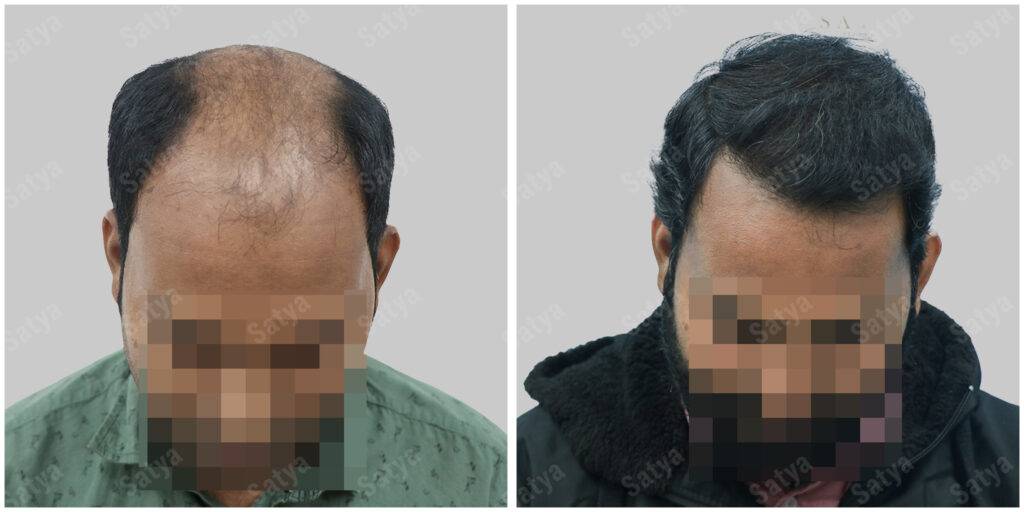What is Traction Alopecia?
Traction alopecia is a type of hair loss that occurs due to consistent pulling or tension on the hair. It is commonly seen in people who style their hair in tight braids, ponytails, and buns that put a lot of pressure on the hair roots and scalp. Over time, this can cause the hair follicles to become damaged, leading to permanent hair loss.
Benefits of Treating Traction Alopecia
Traction alopecia is a type of hair loss caused by the constant pulling and tension on the hair follicles, typically from hairstyles such as tight braids, cornrows, and weaves. Treating traction alopecia can bring several benefits, including:
Hair Regrowth: The main goal of treating traction alopecia is to promote hair regrowth in affected areas. With proper treatment, it is possible to reverse the hair loss caused by traction alopecia and restore a full head of hair.
Improved Appearance: Traction alopecia can result in patchy hair loss and an uneven hairline, significantly affecting a person’s appearance. Treating it can help to improve patient’s appearance and boost their confidence.
Reduced Tension: Treating traction alopecia involves addressing the underlying cause of hair loss, which is the constant pulling and tension on hair follicles. By reducing this tension, patients can reduce the likelihood of further hair loss and improve the overall health of their scalp and hair.
Preventing Further Damage: If left untreated, traction alopecia can progress and lead to permanent hair loss. Earlier treatment can prevent further damage and preserve the hair for the long term.
The procedure of Treating Traction Alopecia
Traction Alopecia is a type of hair loss that occurs due to tension or stress on the hair follicles caused by tight hairstyles such as braids, cornrows, tight buns, and hair extensions. The procedure for treating traction alopecia varies based on the extent of hair loss and the individual’s specific needs. Below are the steps involved in the treatment of traction alopecia:
Consultation: The first step in the treatment process is a consultation with a hair specialist. During this appointment, the specialist will assess the extent of your hair loss, review your medical history, and discuss your hair care and styling habits to determine the best course of action.
Diagnosis: The next step is to diagnose the cause of your traction alopecia. This involves a scalp and hair examination, along with blood tests to rule out underlying medical conditions contributing to your hair loss.
Medical Treatment: If the underlying cause of your traction alopecia is hormonal imbalances or a medical condition, your hair specialist may prescribe medication or other treatments to address the root cause.
Stop Traction: To prevent further hair loss, it is important to stop the Traction or stress on the hair follicles. This may involve changing your hairstyle, wearing your hair down, or avoiding tight hairstyles that cause tension in the hair follicles.
Hair Transplant: In severe cases of traction alopecia, a hair transplant may be necessary to restore hair growth. Hair transplantation involves transplanting hair follicles from one area of the scalp to another. This procedure is typically performed under local anesthesia and can take several hours to complete.
Aftercare: After the procedure, following the aftercare instructions provided by your hair specialist to promote optimal hair growth and minimize the risk of complications is crucial. This includes using hair products that promote hair growth and avoiding tight styles.
Risks and Complications of Treating Traction Alopecia
Infection: There is a risk of infection following any medical procedure.
Scarring: In some cases, scarring may occur at the incision site.
Unsatisfactory Results: As with any cosmetic procedure, there is a risk of unsatisfactory results.
Cost of Treating Traction Alopecia in India
The cost of treating Traction Alopecia in India varies depending on the severity of the condition and the chosen treatment method. Some standard treatment options include hair transplantation, micro scalp pigmentation, and hair restoration surgery. The cost can range from a few thousand rupees for non-invasive treatments to several lakhs for surgical procedures.
It is important to remember that the cost of Traction Alopecia treatment is not just limited to the procedure itself but also includes pre-operative consultations, post-operative care, and follow-up visits. Additionally, the surgeon’s experience and expertise and the clinic’s reputation can also impact the overall cost.
It is advisable to consult with a specialist at Satya Hair Solutions to get a personalized quote for your specific case. With their commitment to providing high-quality hair restoration services and their experience in successfully treating Traction Alopecia, you can be assured that you are in good hands.
Why Choose Satya Hair Solutions for Traction Alopecia?
Experience and Expertise: Satya Hair Solutions has a team of highly skilled and experienced hair restoration specialists who have extensive knowledge and expertise in treating Traction Alopecia. They use the latest techniques and methods to provide patients with natural-looking and long-lasting results.
Customized Treatment Plans: The team at Satya Hair Solutions understands that each patient’s hair loss is unique. They create customized treatment plans to suit each individual’s specific needs.
State-of-the-Art Technology: Satya Hair Solutions uses cutting-edge technology and equipment to ensure that all procedures are performed accurately.
Comprehensive Care: The team at Satya Hair Solutions provides comprehensive care to patients, ensuring they receive the best possible results. From the initial consultation to aftercare, they are with the patient every step of the way.
Patient-Centered Approach: Satya Hair Solutions puts the needs and concerns of its patients first. They provide a comfortable and supportive environment where patients can discuss their hair loss issues and receive guidance to make informed decisions about their treatment.
Book an appointment
Consultation

Repair

Blog

Galleries

Frequently Asked Questions
While tight hairstyles are a common cause of traction alopecia, any consistent tension or pulling on the hair follicles can lead to this condition. This can include the use of tight headbands, hair weaves, and hair extensions.
In many cases, traction alopecia is reversible with appropriate treatment. However, the extent of reversibility depends on factors such as the severity of the condition and how promptly treatment is initiated.
The timeline for visible results from treatment can vary from person to person. It may take several months to see noticeable improvements, and consistent follow-up with a healthcare provider is crucial to monitor progress.
Yes, traction alopecia can result in permanent hair loss if the condition is left untreated for an extended period. That's why it's essential to seek treatment as soon as symptoms are noticed.
Traction alopecia is preventable by avoiding hairstyles and practices that put excessive tension on the hair follicles. It's essential to choose hairstyles that prioritize the health of your hair and scalp.
Yes, but it's essential to choose protective styles that do not exert excessive tension on the hair follicles. Consult with your healthcare provider or hairstylist for recommendations on safe protective styles.
Yes, non-surgical treatment options for traction alopecia may include topical treatments, medications to promote hair growth, and lifestyle modifications to reduce hair tension. The most appropriate option depends on the individual's condition and its severity.
Traction alopecia can affect both men and women, but it may be more commonly associated with certain hairstyles in women, such as tight braids and weaves. However, men who consistently wear tight hairstyles or engage in practices that stress the hair follicles can also develop traction alopecia.




